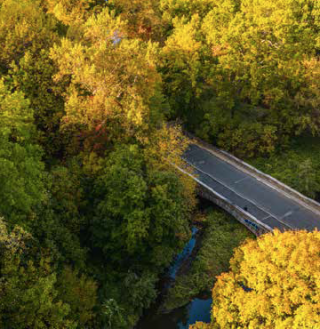Nurturing Nature’s Resilience: Thain Family Forest Program
Posted in Garden News on November 29, 2019 by Jessica Arcate Schuler
Jessica Arcate Schuler is the Director of the Thain Family Forest at The New York Botanical Garden.
 Ecological restoration is the driving discipline for the ongoing work in the Thain Family Forest. This newer field of science is defined by the Society for Ecological Restoration (SER) as the process of assisting the recovery of an ecosystem that has been degraded, damaged, or destroyed. Ecosystems around the world are being used unsustainably and in some cases completely destroyed. Because of this, they are no longer providing vital ecosystem services such as food, water, carbon sequestration, pollination, climate regulation, and wildlife habitat. Ecological restoration provides the platform for people to utilize both conservation and sustainable development techniques to restore ecological function and improve conditions for everyone. The SER has developed international standards that guide restoration projects across the globe with an emphasis on educating and engaging local communities. Through the Forest Program, NYBG is a member of SER and also the Ecological Restoration Alliance of Botanic Gardens where our collaborative declaration is to “Connect. Share. Restore.”
Ecological restoration is the driving discipline for the ongoing work in the Thain Family Forest. This newer field of science is defined by the Society for Ecological Restoration (SER) as the process of assisting the recovery of an ecosystem that has been degraded, damaged, or destroyed. Ecosystems around the world are being used unsustainably and in some cases completely destroyed. Because of this, they are no longer providing vital ecosystem services such as food, water, carbon sequestration, pollination, climate regulation, and wildlife habitat. Ecological restoration provides the platform for people to utilize both conservation and sustainable development techniques to restore ecological function and improve conditions for everyone. The SER has developed international standards that guide restoration projects across the globe with an emphasis on educating and engaging local communities. Through the Forest Program, NYBG is a member of SER and also the Ecological Restoration Alliance of Botanic Gardens where our collaborative declaration is to “Connect. Share. Restore.”
As a 50-acre, old-growth forest in the center of the Bronx, the Thain Family Forest has been degraded by human activity in and around it for hundreds of years. To name a few threats, there are invasive species, soil compaction, loss of native species, and an overabundance of small mammals. However, it is remarkably resilient and considered a model forest for the New York City region dominated by native species and containing an intact forest structure (understory, midstory, and canopy). Unlike regional forests, the Forest does not have the same threats of deer overabundance and invasive vinelands, at this point. The main objective is to keep it that way, and staff, volunteers, and students work tirelessly to monitor, prevent new invasive species, contain existing populations of invasive species, and restore native species. This work is multidisciplinary and engages schoolchildren to retirees to naturalists to corporate volunteers, thus accomplishing ecological restoration at its fullest potential by including local people in the act of restoration.
Right now, the future is bleak for biodiversity and ecosystem function worldwide. But as with any challenge, there are creative solutions that we can all participate in. 2021–2030 is the UN Decade on Ecosystem Restoration, and the Thain Family Forest Program is here to inspire you to take action in your local natural area and work with the community to inventory, manage and restore ecosystem function. With effort, there will be successes and the resilience of any ecosystem may surprise you. Let’s all work to provide functioning ecosystems for future generations.
This article originally appeared as part of the Fall 2019-Winter 2020 issue of Garden News, NYBG’s seasonal newsletter. For further reading, view the issue online and discover a sampling of stories about current programs and undertaking at the Garden.

